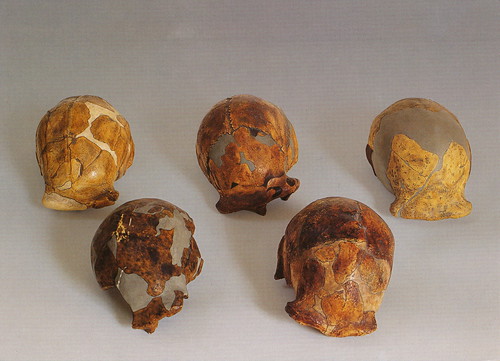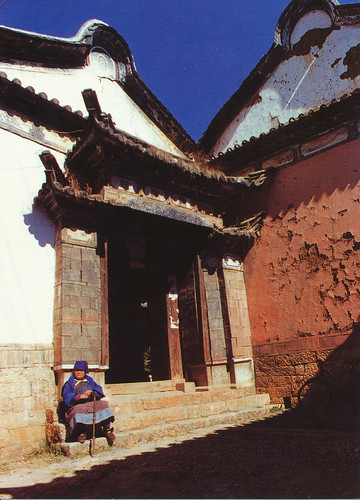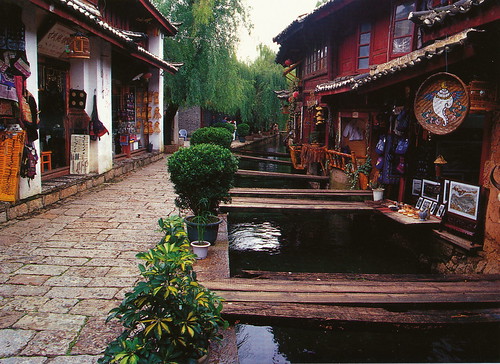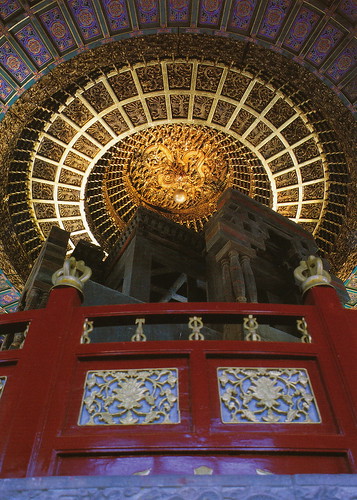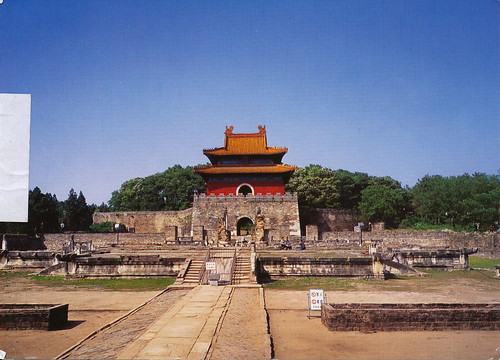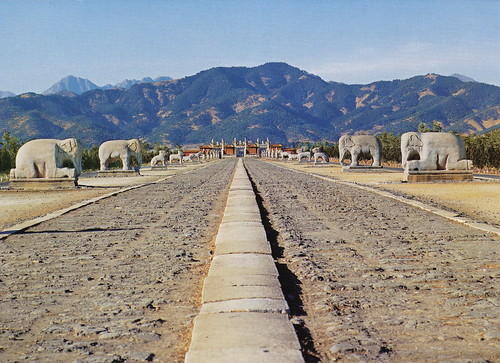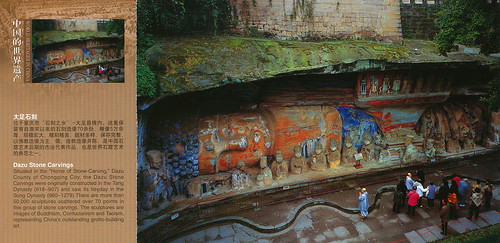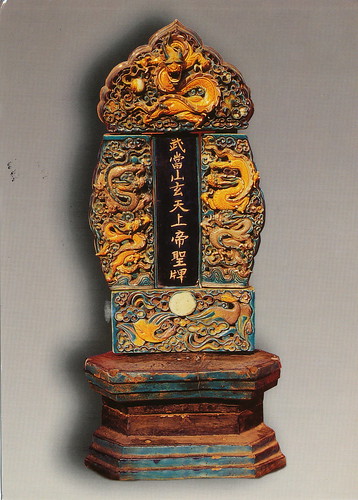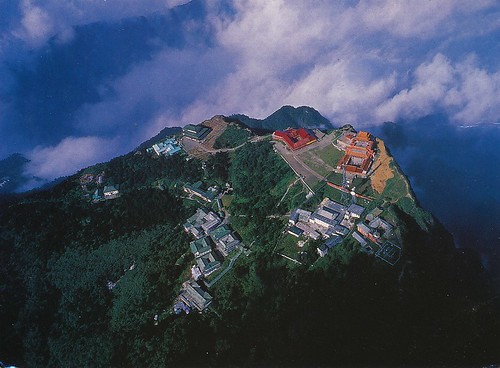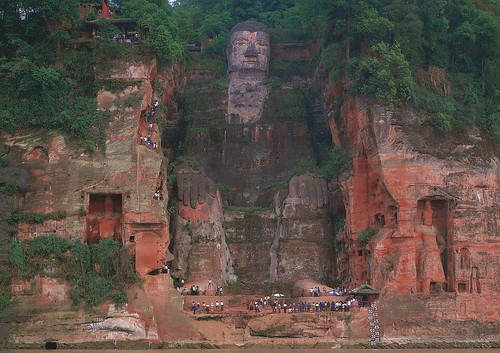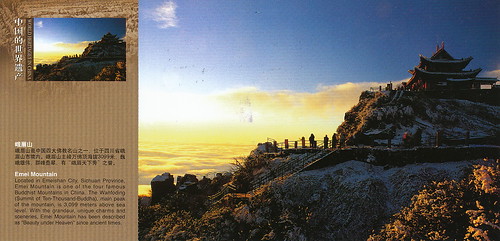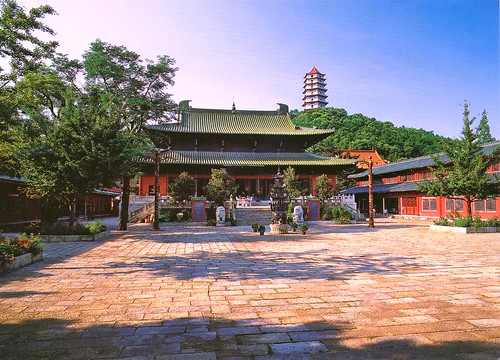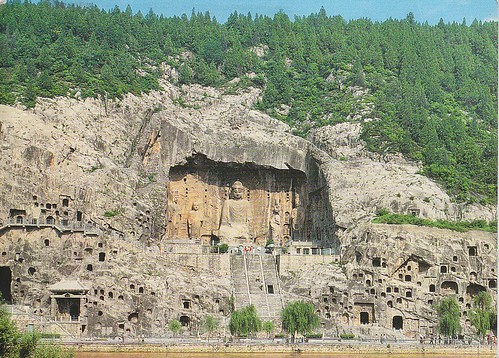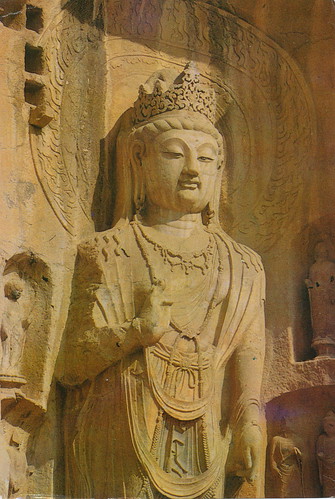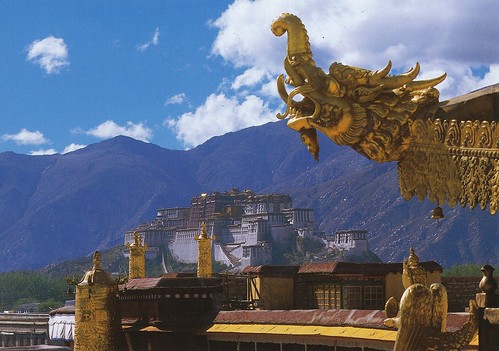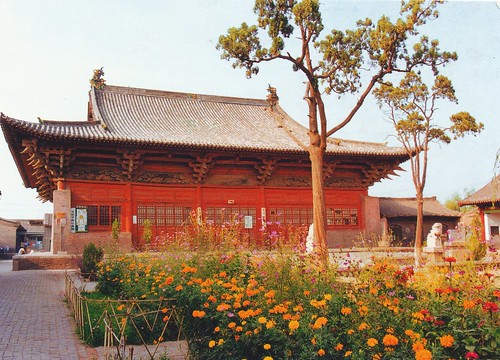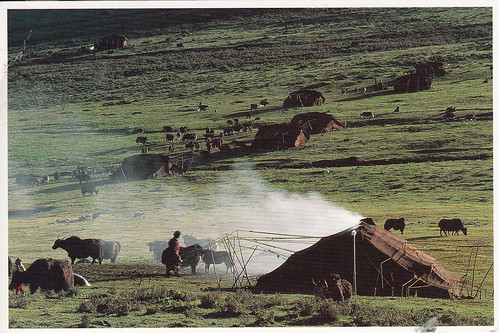Scientific work at the site, which lies 42 km south-west of Beijing, is still underway. So far, it has led to the discovery of the remains of Sinanthropus pekinensis, who lived in the Middle Pleistocene, along with various objects, and remains of Homo sapiens sapiens dating as far back as 18,000–11,000 B.C. The site is not only an exceptional reminder of the prehistorical human societies of the Asian continent, but also illustrates the process of evolution.
Year of Inscription: 1987
http://whc.unesco.org/en/list/449
Showing posts with label China - 41. Show all posts
Showing posts with label China - 41. Show all posts
02/08/2014
30/07/2014
China - Old Town of Lijiang
The Old Town of Lijiang, which is perfectly adapted to the uneven topography of this key commercial and strategic site, has retained a historic townscape of high quality and authenticity. Its architecture is noteworthy for the blending of elements from several cultures that have come together over many centuries. Lijiang also possesses an ancient water-supply system of great complexity and ingenuity that still functions effectively today.
Year of Inscription: 1997
http://whc.unesco.org/en/list/811
Year of Inscription: 1997
http://whc.unesco.org/en/list/811
26/07/2014
China - Mountain Resort and its Outlying Temples, Chengde
The Mountain Resort (the Qing dynasty's summer palace), in Hebei Province, was built between 1703 and 1792. It is a vast complex of palaces and administrative and ceremonial buildings. Temples of various architectural styles and imperial gardens blend harmoniously into a landscape of lakes, pastureland and forests. In addition to its aesthetic interest, the Mountain Resort is a rare historic vestige of the final development of feudal society in China.
Year of Inscription: 1994
http://whc.unesco.org/en/list/703
Year of Inscription: 1994
http://whc.unesco.org/en/list/703
24/07/2014
China - Imperial Tombs of the Ming and Qing Dynasties
It represents the addition of three Imperial Tombs of the Qing Dynasty in Liaoning to the Ming tombs inscribed in 2000 and 2003. The Three Imperial Tombs of the Qing Dynasty in Liaoning Province include the Yongling Tomb, the Fuling Tomb, and the Zhaoling Tomb, all built in the 17th century. Constructed for the founding emperors of the Qing Dynasty and their ancestors, the tombs follow the precepts of traditional Chinese geomancy and fengshui theory. They feature rich decoration of stone statues and carvings and tiles with dragon motifs, illustrating the development of the funerary architecture of the Qing Dynasty. The three tomb complexes, and their numerous edifices, combine traditions inherited from previous dynasties and new features of Manchu civilization.
year of Inscription: 2004
http://whc.unesco.org/en/list/1004
year of Inscription: 2004
http://whc.unesco.org/en/list/1004
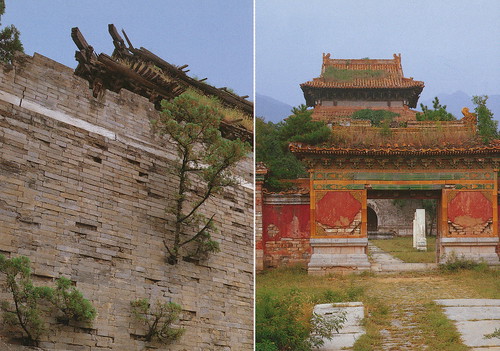 |
22/07/2014
China - Historic Monuments of Dengfeng in “The Centre of Heaven and Earth”
Mount Songshang is considered to be the central sacred mountain of China. At the foot of this 1500 metre high mountain, close to the city of Dengfeng in Henan province and spread over a 40 square-kilometre circle, stand eight clusters of buildings and sites, including three Han Que gates - remains of the oldest religious edifices in China -, temples, the Zhougong Sundial Platform and the Dengfeng Observatory. Constructed over the course of nine dynasties, these buildings are reflections of different ways of perceiving the centre of heaven and earth and the power of the mountain as a centre for religious devotion. The historical monuments of Dengfeng include some of the best examples of ancient Chinese buildings devoted to ritual, science, technology and education.
Year of Inscription: 2010
further Informations: http://whc.unesco.org/en/list/1305
Year of Inscription: 2010
further Informations: http://whc.unesco.org/en/list/1305
20/07/2014
China - Dazu Rock Carvings
The steep hillsides of the Dazu area contain an exceptional series of rock carvings dating from the 9th to the 13th century. They are remarkable for their aesthetic quality, their rich diversity of subject matter, both secular and religious, and the light that they shed on everyday life in China during this period. They provide outstanding evidence of the harmonious synthesis of Buddhism, Taoism and Confucianism.
Year of Inscription: 1999
further Informations: http://whc.unesco.org/en/list/912
Year of Inscription: 1999
further Informations: http://whc.unesco.org/en/list/912
14/07/2014
China - Ancient Building Complex in the Wudang Mountains
The palaces and temples which form the nucleus of this group of secular and religious buildings exemplify the architectural and artistic achievements of China's Yuan, Ming and Qing dynasties. Situated in the scenic valleys and on the slopes of the Wudang mountains in Hubei Province, the site, which was built as an organized complex during the Ming dynasty (14th–17th centuries), contains Taoist buildings from as early as the 7th century. It represents the highest standards of Chinese art and architecture over a period of nearly 1,000 years.
Year of inscription: 1994
further Informations: http://whc.unesco.org/en/list/705
Year of inscription: 1994
further Informations: http://whc.unesco.org/en/list/705
29/06/2014
China - Mount Emei Scenic Area, including Leshan Giant Buddha Scenic Area
The first Buddhist temple in China was built here in Sichuan Province in the 1st century A.D. in the beautiful surroundings of the summit Mount Emei. The addition of other temples turned the site into one of Buddhism's holiest sites. Over the centuries, the cultural treasures grew in number. The most remarkable is the Giant Buddha of Leshan, carved out of a hillside in the 8th century and looking down on the confluence of three rivers. At 71 m high, it is the largest Buddha in the world. Mount Emei is also notable for its exceptionally diverse vegetation, ranging from subtropical to subalpine pine forests. Some of the trees there are more than 1,000 years old.
Year of Inscription: 1996
http://whc.unesco.org/en/list/779
Year of Inscription: 1996
http://whc.unesco.org/en/list/779
28/06/2014
China - Lushan National Park - China
Mount Lushan, in Jiangxi, is one of the spiritual centres of Chinese civilization. Buddhist and Taoist temples, along with landmarks of Confucianism, where the most eminent masters taught, blend effortlessly into a strikingly beautiful landscape which has inspired countless artists who developed the aesthetic approach to nature found in Chinese culture.
Date of Inscription: 1996
http://whc.unesco.org/en/list/778
Date of Inscription: 1996
http://whc.unesco.org/en/list/778
China - Longmen Grottoes
The grottoes and niches of Longmen contain the largest and most impressive collection of Chinese art of the late Northern Wei and Tang Dynasties (316-907). These works, entirely devoted to the Buddhist religion, represent the high point of Chinese stone carving.
Date of Inscription: 2000
http://whc.unesco.org/en/list/1003
Date of Inscription: 2000
http://whc.unesco.org/en/list/1003
China - Imperial Palaces of the Ming and Qing Dynasties in Beijing and Shenyang - China
Seat of supreme power for over five centuries (1416-1911), the Forbidden City in Beijing, with its landscaped gardens and many buildings (whose nearly 10,000 rooms contain furniture and works of art), constitutes a priceless testimony to Chinese civilization during the Ming and Qing dynasties. The Imperial Palace of the Qing Dynasty in Shenyang consists of 114 buildings constructed between 1625–26 and 1783. It contains an important library and testifies to the foundation of the last dynasty that ruled China, before it expanded its power to the centre of the country and moved the capital to Beijing. This palace then became auxiliary to the Imperial Palace in Beijing. This remarkable architectural edifice offers important historical testimony to the history of the Qing Dynasty and to the cultural traditions of the Manchu and other tribes in the north of China.
Date of Inscription: 1987
http://whc.unesco.org/en/list/439
This Post is Part from the Sunday Stamp Blog - especially the chinese stamps. I always like to get chinese postcard due to the stamps :) They are always big and colorful and the marks are most of the time blotted... sometimes i also wish i could read chinese... coz otherwise i've never an idea what the stamps are showing...
Date of Inscription: 1987
http://whc.unesco.org/en/list/439
This Post is Part from the Sunday Stamp Blog - especially the chinese stamps. I always like to get chinese postcard due to the stamps :) They are always big and colorful and the marks are most of the time blotted... sometimes i also wish i could read chinese... coz otherwise i've never an idea what the stamps are showing...
China - Historic Ensemble of the Potala Palace, Lhasa
The Potala Palace, winter palace of the Dalai Lama since the 7th century, symbolizes Tibetan Buddhism and its central role in the traditional administration of Tibet. The complex, comprising the White and Red Palaces with their ancillary buildings, is built on Red Mountain in the centre of Lhasa Valley, at an altitude of 3,700m. Also founded in the 7th century, the Jokhang Temple Monastery is an exceptional Buddhist religious complex. Norbulingka, the Dalai Lama's former summer palace, constructed in the 18th century, is a masterpiece of Tibetan art. The beauty and originality of the architecture of these three sites, their rich ornamentation and harmonious integration in a striking landscape, add to their historic and religious interest.
year of Inscription: 1994
further Informations: http://whc.unesco.org/en/list/707
year of Inscription: 1994
further Informations: http://whc.unesco.org/en/list/707
China - Historic Centre of Macao
Macao, a lucrative port of strategic importance in the development of international trade, was under Portuguese administration from the mid-16th century until 1999, when it came under Chinese sovereignty. With its historic street, residential, religious and public Portuguese and Chinese buildings, the historic centre of Macao provides a unique testimony to the meeting of aesthetic, cultural, architectural and technological influences from East and West. The site also contains a fortress and a lighthouse, the oldest in China. It bears witness to one of the earliest and longest-lasting encounters between China and the West, based on the vibrancy of international trade.
Year of Inscription: 2005
further Informations: http://whc.unesco.org/en/list/1110
Year of Inscription: 2005
further Informations: http://whc.unesco.org/en/list/1110
China - Fujian Tulou
Fujian Tulou is a property of 46 buildings constructed between the 15th and 20th centuries over 120 km in south-west of Fujian province, inland from the Taiwan Strait. Set amongst rice, tea and tobacco fields the Tulou are earthen houses. Several storeys high, they are built along an inward-looking, circular or square floor plan as housing for up to 800 people each. They were built for defence purposes around a central open courtyard with only one entrance and windows to the outside only above the first floor. Housing a whole clan, the houses functioned as village units and were known as “a little kingdom for the family” or “bustling small city.” They feature tall fortified mud walls capped by tiled roofs with wide over-hanging eaves. The most elaborate structures date back to the 17th and 18th centuries. The buildings were divided vertically between families with each disposing of two or three rooms on each floor. In contrast with their plain exterior, the inside of the tulou were built for comfort and were often highly decorated. They are inscribed as exceptional examples of a building tradition and function exemplifying a particular type of communal living and defensive organization, and, in terms of their harmonious relationship with their environment, an outstanding example of human settlement.
Year of Inscription: 2008
further Informations: http://whc.unesco.org/en/list/1113
Year of Inscription: 2008
further Informations: http://whc.unesco.org/en/list/1113
24/06/2014
China - Classical Gardens of Suzhou
Classical Chinese garden design, which seeks to recreate natural landscapes in miniature, is nowhere better illustrated than in the nine gardens in the historic city of Suzhou. They are generally acknowledged to be masterpieces of the genre. Dating from the 11th-19th century, the gardens reflect the profound metaphysical importance of natural beauty in Chinese culture in their meticulous design.
Year of Inscription: 1997
http://whc.unesco.org/en/list/813
Year of Inscription: 1997
http://whc.unesco.org/en/list/813
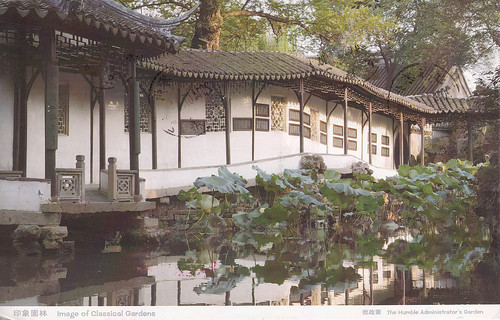 |
| JulyRR - 01 - cmjscmgcm (18.07.104) |
China - Ancient Villages in Southern Anhui – Xidi and Hongcun
The two traditional villages of Xidi and Hongcun preserve to a remarkable extent the appearance of non-urban settlements of a type that largely disappeared or was transformed during the last century. Their street plan, their architecture and decoration, and the integration of houses with comprehensive water systems are unique surviving examples.
Date of Inscription: 2000
further Informations: http://whc.unesco.org/en/list/1002
Date of Inscription: 2000
further Informations: http://whc.unesco.org/en/list/1002
 |
 |
China - Ancient City of Ping Yao
Ping Yao is an exceptionally well-preserved example of a traditional Han Chinese city, founded in the 14th century. Its urban fabric shows the evolution of architectural styles and town planning in Imperial China over five centuries. Of special interest are the imposing buildings associated with banking, for which Ping Yao was the major centre for the whole of China in the 19th and early 20th centuries.
Date of Inscription: 1997
further Informations: http://whc.unesco.org/en/list/812
Date of Inscription: 1997
further Informations: http://whc.unesco.org/en/list/812
23/06/2014
China - Huanglong Scenic and Historic Interest Area
Situated in the north-west of Sichaun Province, the Huanglong valley is made up of snow-capped peaks and the easternmost of all the Chinese glaciers. In addition to its mountain landscape, diverse forest ecosystems can be found, as well as spectacular limestone formations, waterfalls and hot springs. The area also has a population of endangered animals, including the giant panda and the Sichuan golden snub-nosed monkey.
Date of Inscription: 1992
further Informations: http://whc.unesco.org/en/list/638
Date of Inscription: 1992
further Informations: http://whc.unesco.org/en/list/638
 |
18/11/2013
China - Cultural Landscape of Honghe Hani Rice Terraces
The Cultural Landscape of Honghe Hani Rice Terraces, China covers 16,603-hectares in Southern Yunnan. It is marked by spectacular terraces that cascade down the slopes of the towering Ailao Mountains to the banks of the Hong River. Over the past 1,300 years, the Hani people have developed a complex system of channels to bring water from the forested mountaintops to the terraces. They have also created an integrated farming system that involves buffalos, cattle, ducks, fish and eel and supports the production of red rice, the area’s primary crop. The inhabitants worship the sun, moon, mountains, rivers, forests and other natural phenomena including fire. They live in 82 villages situated between the mountaintop forests and the terraces. The villages feature traditional thatched “mushroom” houses. The resilient land management system of the rice terraces demonstrates extraordinary harmony between people and their environment, both visually and ecologically, based on exceptional and long-standing social and religious structures.
Year of Inscription: 2013
further Informations: http://whc.unesco.org/en/list/1111
Year of Inscription: 2013
further Informations: http://whc.unesco.org/en/list/1111
Subscribe to:
Posts (Atom)
